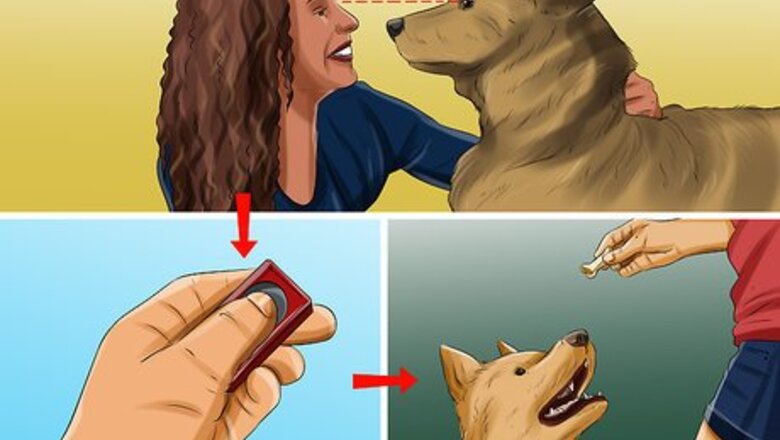
views
Teaching Your Dog Good Manners
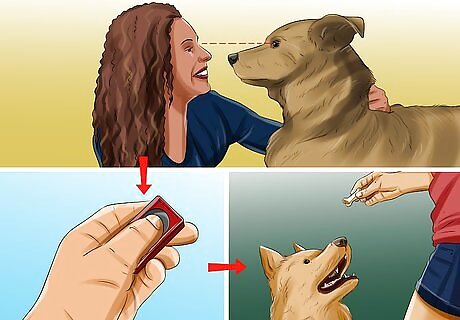
Use clicker training. Clicker training is a great tool to teach your dog all of the skills it needs. To get started, sit across from your dog and wait until it meets your eyes. Then click your clicker and give it a treat. Click and offer a treat a few more times until your dog begins to look for the treat when it hears a click. Test your dog by asking it to do something simple it already knows how to do, such take its favorite toy from you. Then click and give it a treat. If it succeeds, you're ready to use your clicker for training tasks.
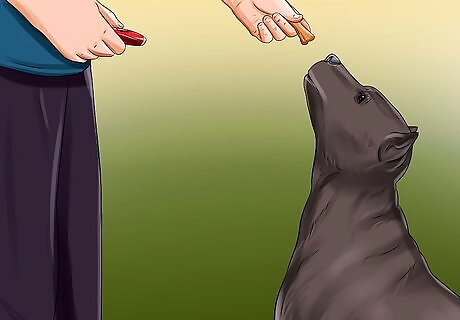
Teach obedience skills. Your dog must learn basic obedience commands, which include sit, stay, come, down, and heel. It should also know a command to return a dropped leash, such as "leash." Not only will this make your dog easier to train, but it’s also required for your dog to be used in public as a service dog. To teach each skill, hold a treat over the dog’s nose, then give the command. When it correctly performs the command, click and give the dog the treat. You should also praise the dog. It’s best to teach your dog both verbal and hand commands to make it easy to signal it in public. As an alternative, you can send your dog to obedience school.
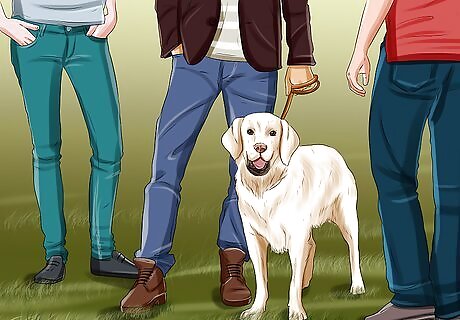
Ensure your dog knows how to behave in public. Service dogs need to act well in public and behave non-aggressively toward other animals, including other barking dogs. If they can’t, they won’t be able to meet your needs. Use your clicker and treats to show your dog which behaviors you want. When you're first training the dog, you may need to leave an area if it's acting inappropriately, which is a normal part of the process. The dog should not bark, bite, nip, lunge, or growl at people or other animals. The dog should not attempt to get food or attention from people while it’s working. The dog should not sniff people, items, or other animals while on duty. The dog should not get too close to other animals while working. The dog should react calmly to strong smells, loud or obnoxious sounds, weird lighting, or unknown locations. The dog should resist dropped food and be able to delay its restroom needs. The dog should walk calmly on its leash without acting out or making noise.
Teaching Service Dog Skills
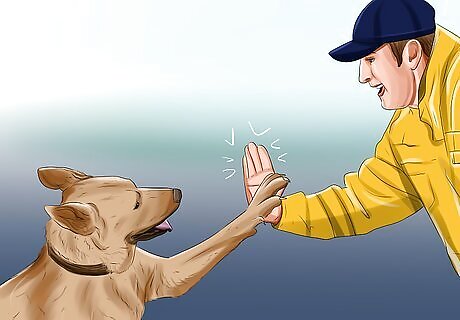
Teach your dog to nudge or pat you. The dog can help disrupt any episodes you experience and bring you back to reality by nudging you with its nose or patting you with its paw. To help, the dog must persist in nudging or patting you until you return to the present. Show your dog a treat in your hand, then fold your hand over it. When it nudges your hand with its nose, click your clicker and open your hand. When the dog learns that nudging gets treats, move a few feet away from it and repeat the process. Continue moving further away from the dog until the dog knows to come to you even if you’re all the way across the room. When training the dog, teach it to recognize your symptoms or respond to a command, then reward it with a treat. Carry your treats at all times once the dog is working so that it learns to persist until you are able to give it a treat. If you’d prefer that the dog pat you, keep your hand open against your leg but with the treat under it. Then wait for your dog to touch your hand with its paw before giving the treat.

Use the game of fetch to teach your dog to retrieve items. Not only can your dog fetch your medicine, water, or food, it can also bring you comfort items when you’re coping with flashbacks, fears, episodes, and depressing thoughts. Start by using an item you would like the dog to fetch, such as a water bottle, as a toy. For example, take an empty water bottle and throw it so your dog can go retrieve it. As the dog gets used to picking up and bringing the item during play, try placing it on a shelf or table. Call the dog to the area where the item is located, then point it out for them. When the dog picks it up, give it a treat. Next, try to ask for the item. Leave the item in the same place but go to another room. Call your dog and ask for the water bottle. For example, say, “Rover, bring the bottle.” If it does, give it a treat. With each success, reward your dog with treats.
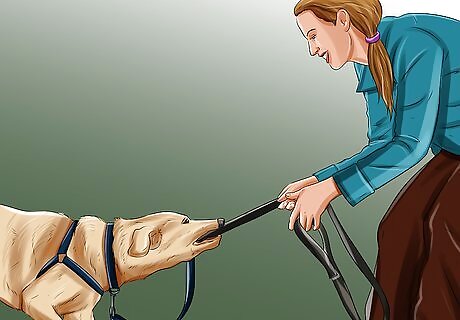
Use tug-of-war to teach your dog to pull. While your dog may not need this skill often, it will help your dog retrieve items for you. For example, if your dog needs to bring you water, it will need to open the refrigerator. Additionally, playing tug-of-war can emotionally help both you and the dog. Begin by playing tug-of-war with your dog using a rope. This should be a game between the two of you that the dog views as play, not training. Once the dog is used to playing, tie the rope to a door at a height where the dog can reach it. Call the dog to the door and hand it the rope. Help it open the door at first, rewarding it with a treat. When the dog successfully opens the door on its own, give it another treat.
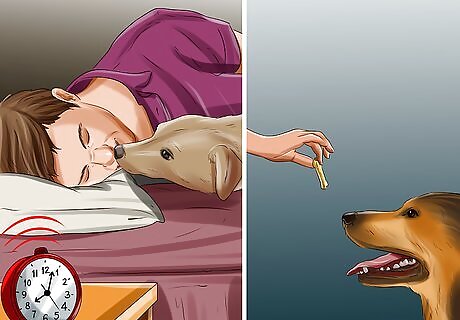
Teach the dog to respond to an alarm clock. If you have trouble waking up, your dog can learn to recognize your alarm. When the alarm goes off, your dog should come wake you. This will help you retain normal waking hours. Start by showing the dog a treat. Press the alarm, then give the dog a treat and praise. Repeat this 10 times. Once your dog starts expecting the treats when it hears a buzz, spread out your training sessions. Press the alarm, then provide a treat and play with your dog for 10-15 minutes. After a few days, bring the alarm back to your bedroom and press it. Your dog should come to you for a treat and playtime. At this point, the dog should be ready to wake you up in the morning.
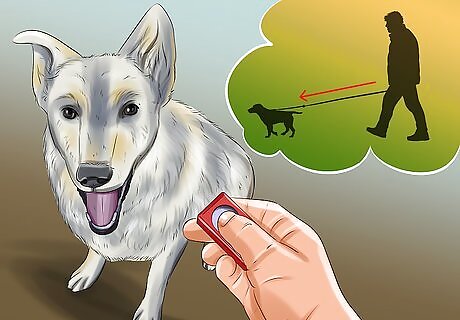
Train the dog to provide you with an exit strategy from stressful situations. Sometimes you may want to exit a stressful situation, such as a loud room or a crowded party. Your dog can learn an exit strategy to give you a reason to leave. For example, the dog can act out so that you must leave to “tend to the dog” or it could learn to lead you toward exits. Like with your other commands, you can use clicker training to teach your dog a "code word" command or hand signal that means it should tug you toward an exit.
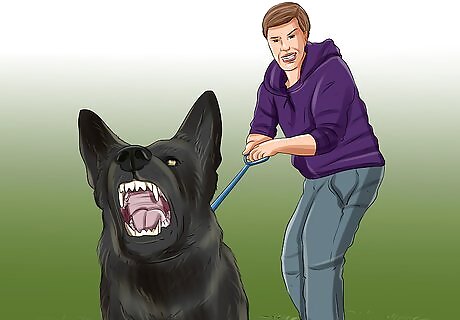
Teach the dog to block crowds. If crowds or strangers provoke episodes for you, train your dog to stand in front of you and refuse to move. This will provide you with the space you need to feel safe and calm. You can use the “sit” and “stay” commands to teach your dog to block you. If you want your dog to block you, use your clicker to teach it to stay in front of you while you're in public. Give it lots of treats and praise at first. Once the dog is used to sitting in front of you, all you'll need to do is give the "sit" and "stay" command to keep it stationed in place.
Using Positive Training Techniques
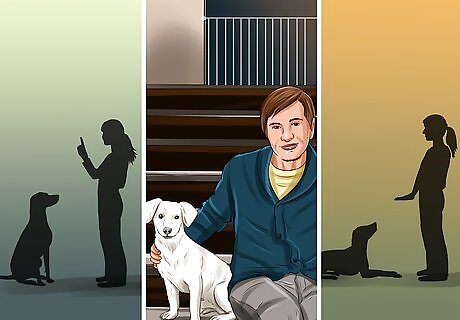
Be patient with your pup. Training a dog to be a service dog takes time, so let your dog learn at its own pace. If you get frustrated, then the dog will begin to dread its training sessions. Try to work with the dog for 10-15 minutes at a time to reduce stress on both of you. It’s okay to do more than 1 training session a day, though no more than 3 sessions per day are recommended. Try to use this time to bond more with your dog.
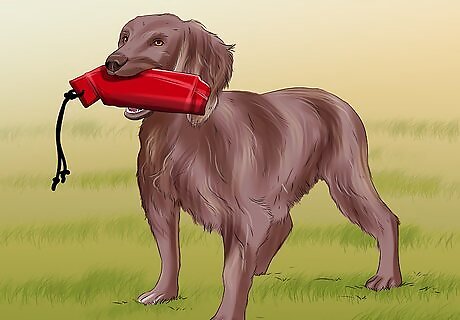
Begin training at 6 months old at the earliest. There is no maximum age, so an older dog can become a great service dog if it has the right disposition. If you don’t know your dog’s age, ask a vet to help estimate it. Keep your dog’s age in mind when considering the tasks you want it to perform. For example, a young dog may be more active than you’d like, and an old dog may be less strong.
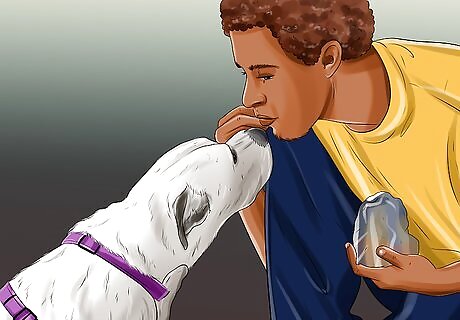
Train your dog for at least 120 hours over a minimum of 6 months. More training than necessary is best, but the minimum requirement to get a dog certified is 120 hours of training over at least a 6 month period. Of those hours, 30 must involve taking the dog in public. Train your dog in short sessions spread over time, and expect to do refresher trainings. You must use positive, non-aggressive training methods in order to certify your dog, so don’t use fear to teach your dog. Stop a training session if the dog gets frustrated or tired, as continuing could make the dog resist training. Remember that the amount of training the dog receives is not what’s most important. The dog must also be able to do the skills required of a service dog.
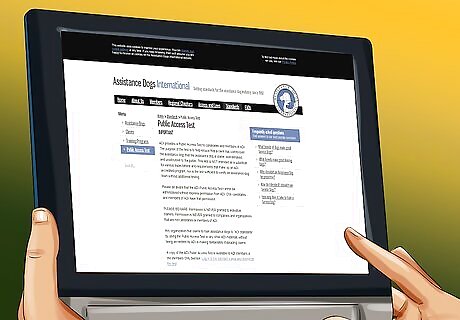
Consider professional training. Training a service dog takes a lot of work, and a professional may be the answer. You can find an accredited trainer by speaking with your dog’s vet or by searching online in your area.




















Comments
0 comment